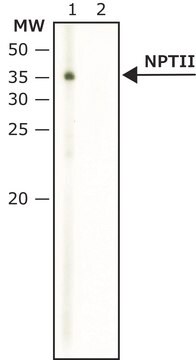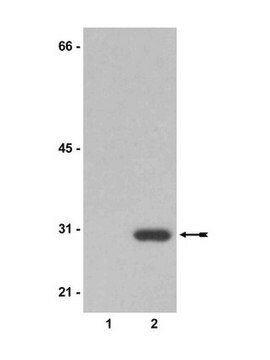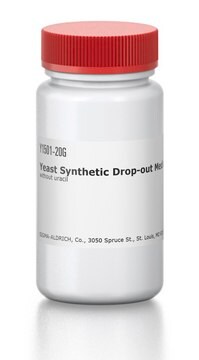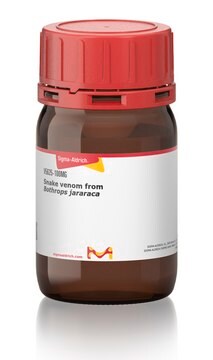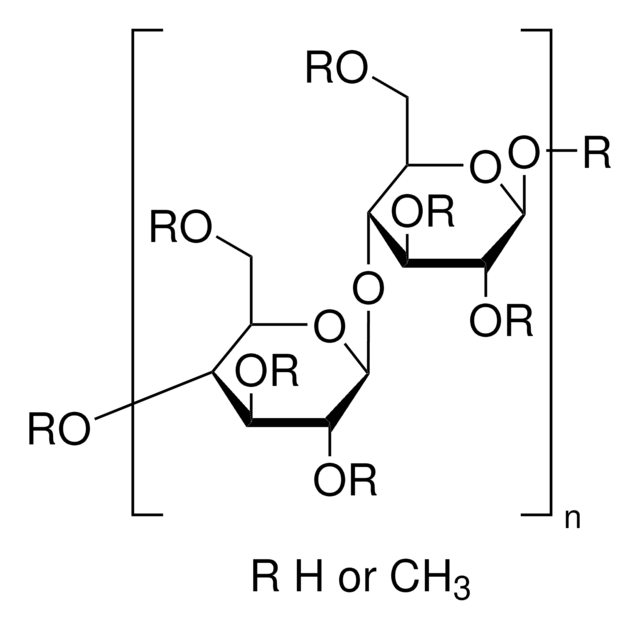176908
Anthrax Protective Antigen, Bacillus anthracis, Nicked, Recombinant, B. anthracis
Sinônimo(s):
PA 63, PA 63
Faça loginpara ver os preços organizacionais e de contrato
About This Item
Código UNSPSC:
12352202
NACRES:
NA.77
Produtos recomendados
Formulário
lyophilized
Nível de qualidade
fabricante/nome comercial
Calbiochem®
condição de armazenamento
OK to freeze
Condições de expedição
ambient
temperatura de armazenamento
2-8°C
Descrição geral
Recombinant, Bacillus anthracis anthrax protective antigen (nicked) expressed in a specialized strain of B. anthracis. PA63 is the carboxyl-terminal 63-kDa fragment obtained by the proteolytic cleavage of the receptor-bound protective antigen (PA), one of the three proteins that comprise anthrax toxin. Unlike native PA, PA63 oligomerizes to form a ring-shaped heptamer that binds up to three copies of EF and/or LF competitively and with high affinity (Kd ~1 nM). Whereas native PA persists on the cell surface, the heptamer is endocytosed, presumably because oligomerization aggregates anthrax toxin receptor. The endocytosed toxic complexes are trafficked to endosomal compartments where the low pH causes the PA63 heptamer to insert into the membrane and form a water-filled channel.
Recombinant, Bacillus anthracis anthrax protective antigen(nicked) expressed in a special strain of B. anthracis. PA63 is the carboxyl-terminal 63-kDa fragment obtained by the proteolytic cleavage of the receptor-bound protective antigen (PA), one of the three proteins that comprise anthrax toxin. Unlike native PA, PA63 oligomerizes to form a ring-shaped heptamer that binds up to three copies of EF and/or LF competitively and with high affinity (Kd ~1 nM). Whereas native PA persists on the cell surface, the heptamer is endocytosed, presumably because oligomerization aggregates anthrax toxin receptor. The endocytosed toxic complexes are trafficked to endosomal compartments where the low pH causes the PA63 heptamer to insert into the membrane and form a water-filled channel.
Ações bioquímicas/fisiológicas
Cell permeable: no
Primary Target
EF and/or LF
EF and/or LF
Product does not compete with ATP.
Reversible: no
Advertência
Toxicity: Standard Handling (A)
forma física
Lyophilized from 100 mM NaCL, 10 mM BIS-Tris propane, 1.25% trehalose, pH 8.5.
Reconstituição
Following reconstitution aliquot and freeze (-20°C or- 70°C) for long term storage or refrigerate (4°C) for short-term (few hours) storage. Avoid rapid freeze-thaw cycles of solutions. Stock solutions are stable for up to 3 months at -20°C or -70°C.
Reconstitute in sterile 50% glycerol or sterile, distilled H₂O to a final concentration of 1 mg/ml. Addition of BSA to a concentration of 1 mg/ml may enhance stability.
Nota de análise
Single major band at 63 kD by SDS-PAGE
Outras notas
Mogridge, J., et al. 2002. Proc. Natl. Acad. Sci. USA99, 7045.
Nassi, S., et al. 2002. Biochemistry41, 1445.
Singh, Y., et al. 1999. Infect. Immun.67, 1853.
Leppla, S.H. 1988. Methods Enzymol.165, 103.
Nassi, S., et al. 2002. Biochemistry41, 1445.
Singh, Y., et al. 1999. Infect. Immun.67, 1853.
Leppla, S.H. 1988. Methods Enzymol.165, 103.
Informações legais
CALBIOCHEM is a registered trademark of Merck KGaA, Darmstadt, Germany
Código de classe de armazenamento
11 - Combustible Solids
Classe de risco de água (WGK)
WGK 1
Ponto de fulgor (°F)
Not applicable
Ponto de fulgor (°C)
Not applicable
Certificados de análise (COA)
Busque Certificados de análise (COA) digitando o Número do Lote do produto. Os números de lote e remessa podem ser encontrados no rótulo de um produto após a palavra “Lot” ou “Batch”.
Já possui este produto?
Encontre a documentação dos produtos que você adquiriu recentemente na biblioteca de documentos.
Nossa equipe de cientistas tem experiência em todas as áreas de pesquisa, incluindo Life Sciences, ciência de materiais, síntese química, cromatografia, química analítica e muitas outras.
Entre em contato com a assistência técnica